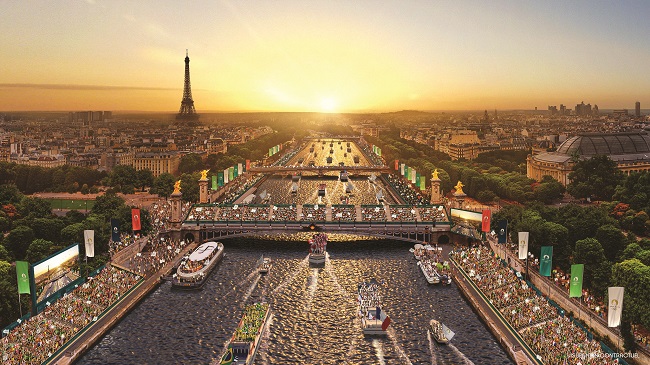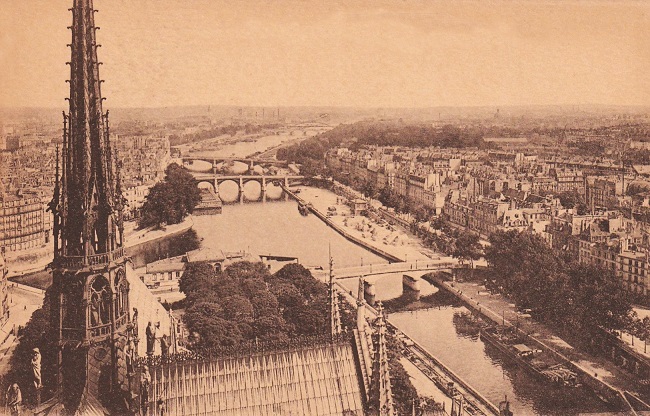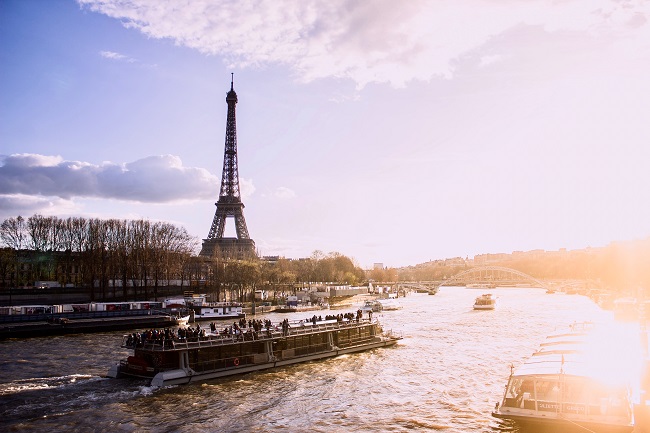Go with the Flow: Following the Seine in and around Paris
No other waterway captures the imagination like the River Seine. It doesn’t hurt that one of the world’s most famous rivers runs through the world capital of romance, passing on its way Paris’s iconic monuments, prized by travellers from around the globe as a backdrop for life’s memorable moments.
On July 26, 2024, all eyes will be on the River Seine as the banks of one of the world’s most famous waterways hosts 600,000 spectators for the first Olympics opening ceremony ever to be held in the open air of a city centre.

Paris has big plans for the Seine for the 2024 Olympic Games © Florian Hulleu
The Seine’s role in the Games won’t stop there: Paris envisions holding Olympic diving and swimming events in three basins installed in the river, the culmination of five years and €1.4bn in sewage and run-off clean-up efforts along the roughly eight-mile stretch of the Seine that runs through Paris. The city hopes to maintain the pools after the Games to allow public swimming. The Seine plays an outsized role in the lives of Parisians, both beloved and taken for granted as a backdrop to everyday life and an inescapable part of the Parisian landscape. Its symbolic power through the ages has been commemorated in countless photos, films, songs and artworks by the likes of Monet, Corot, Matisse, Pissarro and Renoir, who captured a slice of Parisian café life on its banks and at its lively riverside guinguettes.
But most of all, it’s the river’s romance that captures the imagination. Strolling along its leafy banks, unusually accessible via long stretches of cobbled walkways, all the beauty and majesty of Paris is before you, as you pass its bridges and monuments. What’s most exceptional is the river’s intimacy. Removed from traffic and the bustle of city life, on a cool autumn or spring day you can easily find a bench along the river’s edge all to yourself to enjoy unparalleled vistas and contemplate the river’s unhurried flow.

The Pont des Arts and the Ile de la Cité in Paris © Paris Tourist Office
The source of the river
The Seine stretches 777km (483 miles) southeast to northwest between Burgundy and Normandy, where it joins the English Channel at the port city of Le Havre. At its mouth, the river spans 10 miles across, but it begins as a mere trickle in a country grotto 19 miles northwest of Dijon. At the Seine’s humble source – once a pilgrimage point venerated by the Gauls for its healing waters – you can still see the vestiges of a Roman temple. Today, the spring is marked by a marble statue of the Celtic deity Sequana, after whom the river is named.
If you follow the serpentine river from Burgundy through Champagne and into the Île-de-France, you’ll pass rural landscapes, historic towns and sleepy villages, many of which carry the river’s name: Châtillon-sur-Seine, Gyé-sur-Seine, Aisey-sur-Seine. At some places the river is so calm and clear that children grow up splashing in its shallows or chasing trout from its pools. On its way to Paris, it meanders past the medieval city of Troyes – famous for its picturesque old town and lovely Gothic cathedral – where it gains force as it meets the River Aube at Romilly-sur-Seine. Passing the ancient forest of Fontainebleau and the town of Melun, where the sculptor Rodin lived and worked in a house that’s now a museum, the Seine enters Paris, in whose history and fortunes it has played a starring role.

Paris was called Lutèce by the Romans
A riverside view Paris
The history of Paris began on the riverbanks in around 259 BC, when a Gallic tribe called the Parisii settled on the Île de la Cité. About 200 years later, the Romans arrived, claiming the strategic triad of the Île de la Cité, Île Saint-Louis and the Left Bank (now the Latin Quarter) and renaming the burgeoning city Lutèce. The Seine’s two earliest bridges – the Grand Pont and the Petit Pont (rebuilt in 2013 as the Petit-Pont-Cardinal-Lustiger) – spanned the river between the Île de la Cité. Life flourished on the river, as the Seine provided food and water, crucial transport routes, and fertile ground on its banks for farming.
In 1991, UNESCO declared the Seine riverbanks a world heritage site for their “exceptional geography and history”. The protected area is between the Pont de Bir-Hakeim (one of the city’s two stacked bridges and the only one that accommodates the metro, automobiles and pedestrians, who come here for stellar views of the Eiffel Tower) and the Pont de Sully and contains 23 of Paris’s 37 bridges, both islands and 18 of the capital’s iconic monuments, including the Eiffel Tower, the Musée d’Orsay, the Petit and Grand Palais and the Louvre.
There’s no more romantic way to discover Paris than along the Seine, traversing the city’s unique bridges as you go. Avid walkers can do the trip in a day, or two if stopping at monuments along the way. The river is the ideal theme for a long weekend or even a week in and around Paris, along with visits to some of the many riverside attractions just outside the city.
Or perhaps embark on an extended trip along the Seine, say from historic Troyes in the Aube department to beautiful Honfleur on the Seine estuary, with stops at the scores of historic Seine-side towns and villages, a trip that can easily be done by car or by bicycle thanks to the 420km Seine à Vélo bike route.

The city brings in tons of sand every summer for its Paris Plage event © Paris Tourist Office
The Seine in the city
Besides scenic strolls, the Seine riverbanks host dozens of attractions throughout the year that visitors can easily miss. Every July and August, Paris hauls in 5,000 tonnes of sand by barge from Normandy to create the Paris Plage. This urban beach covering three quays has a seaside charm, complete with palm trees, sun umbrellas, deck chairs and activities like Tai chi and volleyball, plus outdoor cafés and concerts.
Along Les Rives de Seine, a pedestrian promenade extending 2.3km (1.4 miles) on the Left Bank and 3.3km (2 miles) on the Right from the Place de la Bastille to the Eiffel Tower, strollers can play ping-pong, scale a climbing wall or take a yoga or Pilates class. The MuMo mobile museum hosts art shows and you can grab lunch or a snack at its street food stands and four terrace cafés. If you’re feeling sleepy, you can rent a private container for a 90-minute nap or host your own get-together for up to eight people. The banks harbour lively nightclubs like Faust and the Tunnel of Love under Pont Alexandre III, Paris’s most photogenic bridge, while barges docked along the water host everything from restaurants to floating electro clubs. Fluctuart, a new ‘immersive’ contemporary arts centre with a rooftop bar and café overlooking the river, is part of City Hall’s ‘Reinventing the Seine’ programme.

The riverbanks of the Seine in Paris are the perfect place for a sunset stroll © Paris Tourist Office
If there is one absolute-must experience on the Seine, put your money on a bateau mouche boat tour, where you’ll see the city bridges and monuments from a unique perspective. There are dozens of boats – and experiences – to be had on them, from a standard narrated tour to a champagne cruise to watch the sunset or the lights of the Eiffel Tower sparkle for five minutes at the top of each hour after sunset until midnight. Even the renowned chef Alain Ducasse, holder of more Michelin stars than any other living chef (21 stars and 30 restaurants), offers an elegant lunch or dinner cruise complete with snowy linens and silver on a perfectly silent electric boat, where you’ll take the last sips of your post-dinner digestif at the foot of a twinkling Eiffel Tower.
While a ride on a bateau mouche is a must, the Batobus is a good budget option. On a €19 day pass (€21 for two days) you can hop on and off the river bus, which stops roughly every 20 minutes at nine of the city’s most visited places, including Invalides, Notre-Dame, the Eiffel Tower, the Musée d’Orsay and the Jardin des Plantes. If you’d rather commandeer your own boat, the start-up Clickandboat offers every kind of vessel you could desire, from sailboats and jet skis to a small yacht.
You can even stay on the river itself in the floating Off Paris Seine hotel, a four-star lodging moored on the Left Bank near the Gare d’Austerlitz train station. The hotel has its own marina and offers cruises on its motorboat. Just downriver, you can swim in the Josephine Baker pool, an 80ft-long basin submerged from a barge in the Seine in front of the Bibliothèque Nationale François Mitterrand. But if you can bear to wait until 2024, you’ll be able to swim directly in the Seine.

Around Paris
At the end of metro line 9, at the Pont de Sèvres stop in the suburb of Boulogne-Billancourt, you’ll find La Seine Musicale, set mid-river on the Île Seguin. It hosts a range of musical events in a soaring glass building designed by architects Shigeru Ban and Jean de Gastines. Besides its eclectic musical programme, the venue offers stunning views of Paris and the river from its café and outdoor terraces. A short walk upriver from the same metro stop, the exceptional Sèvres – Manufacture et Musée nationaux, France’s royal porcelain makers, offers a view of the artists at work, as well as some of the factory’s most famous creations commissioned by world sovereigns since its beginnings in 1740. Its contemporary galleries feature artworks in porcelain made by artists in residence here.
Farther downriver you can visit the beautiful Château de Malmaison, home of Napoleon Bonaparte and his first wife Josephine, who lived out her days here cultivating her famous roses; her gardens remain a highlight of the property to this day. Heading toward Normandy, stop in Seine-side Vernon and Giverny: Vernon’s pretty half-timbered buildings, 11th-century Gothic cathedral and beautiful gardens are often overlooked as visitors flock to Giverny, where Impressionist Claude Monet lived and painted in his famous gardens.
On the way to the mouth of the river at Le Havre, be sure to stop in at Rouen, whose restored old town, Gothic cathedral (immortalised in Monet’s 30 paintings of the cathedral under changing light) and fine art museum are well worth a visit. And don’t miss Honfleur, on the estuary where the Seine meets the Channel; one of France’s most charming towns, it’s where Monet met his spectacularly gifted mentor Eugène Boudin, as well as being the birthplace of the composer Erik Satie.
From France Today Magazine
Lead photo credit : The Seine River passes 18 of Paris' monuments © Diogo Fagundes on Unsplash
Share to: Facebook Twitter LinkedIn Email
More in history of paris, Paris, Paris walks, Seine
Leave a reply
Your email address will not be published. Required fields are marked *






REPLY
REPLY
REPLY
REPLY
REPLY